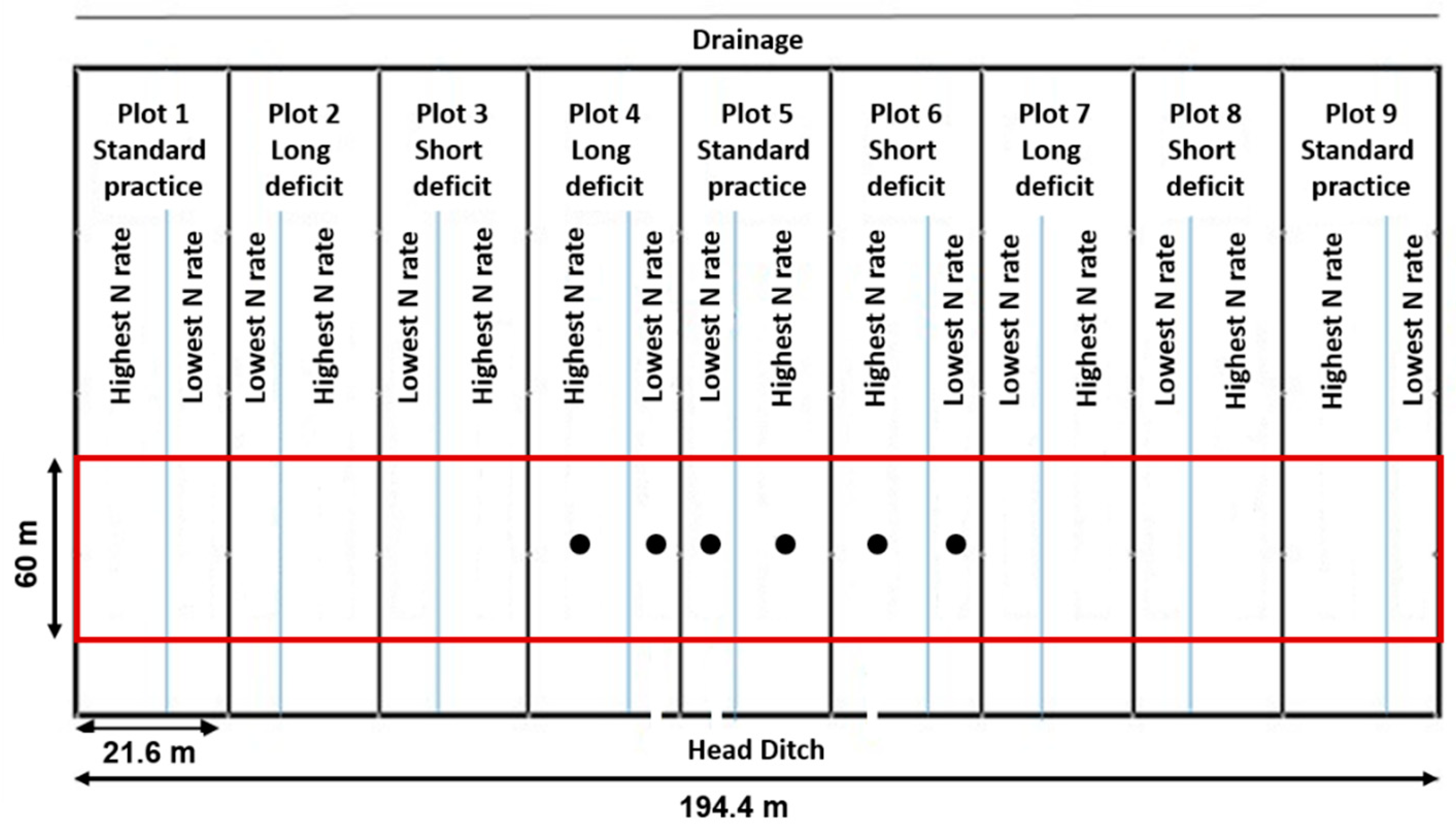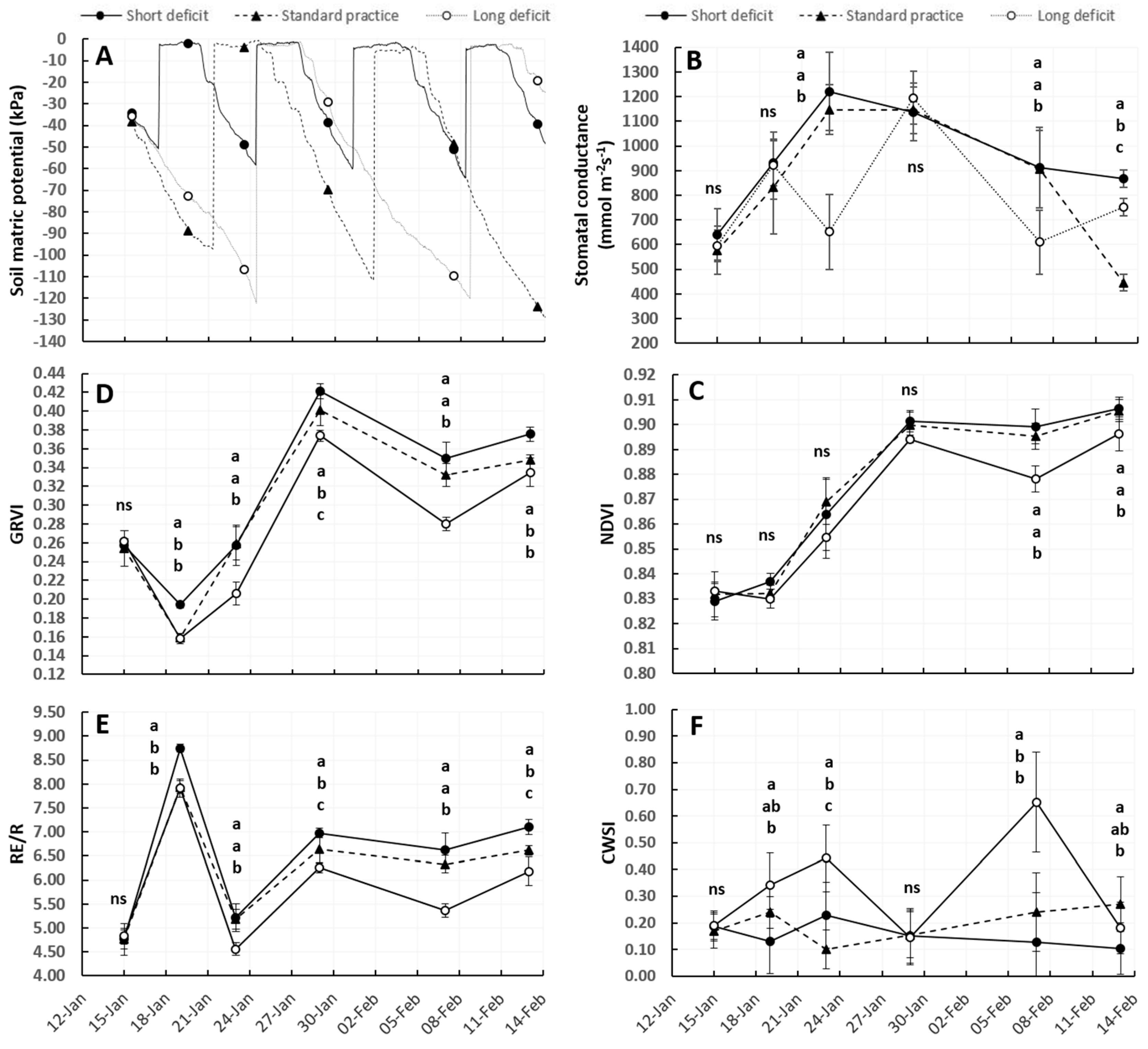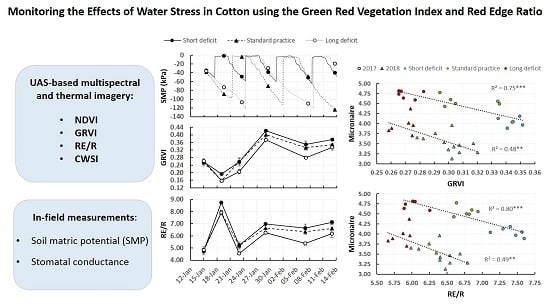Monitoring the Effects of Water Stress in Cotton Using the Green Red Vegetation Index and Red Edge Ratio
Abstract
:1. Introduction
2. Materials and Methods
2.1. Location, Site Characteristics and Treatments
2.2. In-Field Measurements
2.3. Multispectral and Thermal Imagery
2.4. Yield and Lint Quality
2.5. Statistical Analysis
3. Results
3.1. Time Series of In-Field and Remote Sensing Measurements During the 2016/17 Growing Season
3.1.1. Soil and Plant Water Status
3.1.2. Multispectral Indices
3.2. Time Series of In-Field and Remote Sensing Measurements During the 2017/2018 Growing Season
3.2.1. Soil and Plant Water Status
3.2.2. Multispectral Indices and CWSI
3.3. Relationships Between Multispectral Indices and CWSI with Soil Matric Potential and Stomatal Conductance
3.4. Lint Yield, Fibre Quality and Their Relationships with the Multispectral Indices and CWSI
4. Discussion
4.1. Response of the UAS-Based Indices to the Irrigation Frequency
4.2. Performance of the UAS-Based Indices to Predict Soil Matric Potential and Cotton Water Status
4.3. Lint Yield and Lint Quality Prediction
5. Conclusions
Author Contributions
Funding
Acknowledgments
Conflicts of Interest
References
- Alvino, A.; Marino, S. Remote sensing for irrigation of horticultural crops. Horticulturae 2017, 3, 40. [Google Scholar]
- Osakabe, Y.; Osakabe, K.; Shinozaki, K.; Tran, L.-S. Response of plants to water stress. Front. Plant Sci. 2014, 5, 86. [Google Scholar] [CrossRef]
- Baker, J.T.; Gitz, D.C.; Payton, P.; Wanjura, D.F.; Upchurch, D.R. Using leaf gas exchange to quantify drought in cotton irrigated based on canopy temperature measurements. Agron. J. 2007, 99, 637–644. [Google Scholar] [CrossRef]
- Deeba, F.; Pandey, A.K.; Ranjan, S.; Mishra, A.; Singh, R.; Sharma, Y.K.; Shirke, P.A.; Pandey, V. Physiological and proteomic responses of cotton (gossypium herbaceum l.) to drought stress. Plant Physiol. Biochem. 2012, 53, 6–18. [Google Scholar] [CrossRef]
- Wiggins, M.S.; Leib, B.G.; Mueller, T.C.; Main, C.L. Cotton growth, yield, and fiber quality response to irrigation and water deficit in soil of varying depth to a sand layer. J. Cotton Sci. 2014, 18, 145–152. [Google Scholar]
- Brodrick, R.; Yeates, S.; Roth, G.; Gibb, D.; Henggeler, S.; Wigginton, D. Managing irrigated cotton agronomy. In Waterpak—A Guide for Irrigation Management in Cotton and Grain Farming Systems; Dugdale, H., Harris, G., Neilsen, J., Richards, D., Wigginton, D., Williams, D., Eds.; The Cotton Research and Development Corporation: Narrabri, Australia, 2012; pp. 248–263. [Google Scholar]
- Bange, M.P.; Constable, G.A.; Gordon, S.G.; Naylor, M.H.J. Van der Sluijs. In Fibrepak a Guide to Improving Australian Cotton Fibre Quality; The Cotton Research and Development Corporation: Narrabri, Australia, 2009. [Google Scholar]
- Fernández, J. Plant-based methods for irrigation scheduling of woody crops. Horticulturae 2017, 3, 35. [Google Scholar] [CrossRef]
- Ihuoma, S.O.; Madramootoo, C.A. Recent advances in crop water stress detection. Comput. Electron. Agric. 2017, 141, 267–275. [Google Scholar] [CrossRef]
- Cohen, Y.; Alchanatis, V.; Meron, M.; Saranga, Y.; Tsipris, J. Estimation of leaf water potential by thermal imagery and spatial analysis*. J. Exp. Bot. 2005, 56, 1843–1852. [Google Scholar] [CrossRef] [PubMed]
- Ko, J.; Piccinni, G. Characterizing leaf gas exchange responses of cotton to full and limited irrigation conditions. Field Crop. Res. 2009, 112, 77–89. [Google Scholar] [CrossRef]
- Cohen, Y.; Fuchs, M.; Falkenflug, V.; Moreshet, S. Calibrated heat pulse method for determining water uptake in cotton. Agron. J. 1988, 80, 398–402. [Google Scholar] [CrossRef]
- Cohen, Y.; Alchanatis, V.; Saranga, Y.; Rosenberg, O.; Sela, E.; Bosak, A.J.P.A. Mapping water status based on aerial thermal imagery: Comparison of methodologies for upscaling from a single leaf to commercial fields. Precis. Agric. 2017, 18, 801–822. [Google Scholar] [CrossRef]
- Jones, H.G.; Serraj, R.; Loveys, B.R.; Xiong, L.; Wheaton, A.; Price, A.H. Thermal infrared imaging of crop canopies for the remote diagnosis and quantification of plant responses to water stress in the field. Funct. Plant Biol. 2009, 36, 978–989. [Google Scholar] [CrossRef]
- Idso, S.B.; Jackson, R.D.; Pinter, P.J.; Reginato, R.J.; Hatfield, J.L. Normalizing the stress-degree-day parameter for environmental variability. Agric. Meteorol. 1981, 24, 45–55. [Google Scholar] [CrossRef]
- Jackson, R.D.; Idso, S.B.; Reginato, R.J.; Pinter, P.J. Canopy temperature as a crop water stress indicator. Water Resour. Res. 1981, 17, 1133–1138. [Google Scholar] [CrossRef]
- Meron, M.; Tsipris, J.; Orlov, V.; Alchanatis, V.; Cohen, Y.J.P.A. Crop water stress mapping for site-specific irrigation by thermal imagery and artificial reference surfaces. Precis. Agric. 2010, 11, 148–162. [Google Scholar] [CrossRef]
- Bellvert, J.; Zarco-Tejada, P.J.; Girona, J.; Fereres, E.J.P.A. Mapping crop water stress index in a ‘pinot-noir’ vineyard: Comparing ground measurements with thermal remote sensing imagery from an unmanned aerial vehicle. Precis. Agric. 2014, 15, 361–376. [Google Scholar] [CrossRef]
- Gonzalez-Dugo, V.; Zarco-Tejada, P.; Nicolás, E.; Nortes, P.A.; Alarcón, J.J.; Intrigliolo, D.S.; Fereres, E.J.P.A. Using high resolution uav thermal imagery to assess the variability in the water status of five fruit tree species within a commercial orchard. Precis. Agric. 2013, 14, 660–678. [Google Scholar] [CrossRef]
- Matese, A.; Baraldi, R.; Berton, A.; Cesaraccio, C.; Di Gennaro, S.; Duce, P.; Facini, O.; Mameli, M.; Piga, A.; Zaldei, A. Estimation of water stress in grapevines using proximal and remote sensing methods. Remote Sens. 2018, 10, 114. [Google Scholar] [CrossRef]
- Govender, M.; Govender, P.G.; Weiersbye, I.M.; Witkowski, E.T.F.; Ahmed, F. Review of commonly used remote sensing and ground-based technologies to measure plant water stress. Water Sa 2009, 35, 741–752. [Google Scholar] [CrossRef]
- Haise, H.R.; Hagan, R.M. Soil, plant, and evaporative measurements as criteria for scheduling irrigation1. In Irrigation of Agricultural Lands; Hagan, R.M., Haise, H.R., Edminster, T.W., Eds.; American Society of Agronomy: Madison, WI, USA, 1967; pp. 577–604. [Google Scholar]
- Zarco-Tejada, P.J.; Miller, J.R.; Mohammed, G.H.; Noland, T.L.; Sampson, P.H. Chlorophyll fluorescence effects on vegetation apparent reflectance: II. Laboratory and airborne canopy-level measurements with hyperspectral data. Remote Sens. Environ. 2000, 74, 596–608. [Google Scholar] [CrossRef]
- Ju, C.-H.; Tian, Y.-C.; Yao, X.; Cao, W.-X.; Zhu, Y.; Hannaway, D. Estimating leaf chlorophyll content using red edge parameters. Pedosphere 2010, 20, 633–644. [Google Scholar] [CrossRef]
- Ballester, C.; Hornbuckle, J.; Brinkhoff, J.; Smith, J.; Quayle, W. Assessment of in-season cotton nitrogen status and lint yield prediction from unmanned aerial system imagery. Remote Sens. 2017, 9, 1149. [Google Scholar] [CrossRef]
- Frampton, W.J.; Dash, J.; Watmough, G.; Milton, E.J. Evaluating the capabilities of sentinel-2 for quantitative estimation of biophysical variables in vegetation. ISPRS J. Photogramm. Remote Sens. 2013, 82, 83–92. [Google Scholar] [CrossRef]
- Raper, T.B.; Varco, J.J.; Hubbard, K.J. Canopy-based normalized difference vegetation index sensors for monitoring cotton nitrogen status. Agron. J. 2013, 105, 1345–1354. [Google Scholar] [CrossRef]
- Ballester, C.; Zarco-Tejada, P.J.; Nicolás, E.; Alarcón, J.J.; Fereres, E.; Intrigliolo, D.S.; Gonzalez-Dugo, V.J.P.A. Evaluating the performance of xanthophyll, chlorophyll and structure-sensitive spectral indices to detect water stress in five fruit tree species. Precis. Agric. 2018, 19, 178–193. [Google Scholar] [CrossRef]
- Blackburn, G.A. Hyperspectral remote sensing of plant pigments. J. Exp. Bot. 2007, 58, 855–867. [Google Scholar] [CrossRef]
- Gamon, J.A.; Peñuelas, J.; Field, C.B. A narrow-waveband spectral index that tracks diurnal changes in photosynthetic efficiency. Remote Sens. Environ. 1992, 41, 35–44. [Google Scholar] [CrossRef]
- Sims, D.A.; Gamon, J.A. Relationships between leaf pigment content and spectral reflectance across a wide range of species, leaf structures and developmental stages. Remote Sens. Environ. 2002, 81, 337–354. [Google Scholar] [CrossRef]
- Zarco-Tejada, P.J.; Miller, J.R.; Morales, A.; Berjón, A.; Agüera, J. Hyperspectral indices and model simulation for chlorophyll estimation in open-canopy tree crops. Remote Sens. Environ. 2004, 90, 463–476. [Google Scholar] [CrossRef]
- Inoue, Y.; Peñuelas, J.; Miyata, A.; Mano, M. Normalized difference spectral indices for estimating photosynthetic efficiency and capacity at a canopy scale derived from hyperspectral and co2 flux measurements in rice. Remote Sens. Environ. 2008, 112, 156–172. [Google Scholar] [CrossRef]
- Maimaitiyiming, M.; Ghulam, A.; Bozzolo, A.; Wilkins, J.L.; Kwasniewski, M.T. Early detection of plant physiological responses to different levels of water stress using reflectance spectroscopy. Remote Sens. 2017, 9, 745. [Google Scholar] [CrossRef]
- Tucker, C.J. Red and photographic infrared linear combinations for monitoring vegetation. Remote Sens. Environ. 1979, 8, 127–150. [Google Scholar] [CrossRef]
- Motohka, T.; Nasahara, K.N.; Oguma, H.; Tsuchida, S. Applicability of green-red vegetation index for remote sensing of vegetation phenology. Remote Sens. 2010, 2, 2369–2387. [Google Scholar] [CrossRef]
- Chen, A.; Orlov-Levin, V.; Meron, M. Applying high-resolution visible-channel aerial scan of crop canopy to precision irrigation management. Proceedings 2018, 2, 335. [Google Scholar] [CrossRef]
- Cotton Australia. Available online: https://cottonaustralia.com.au/cotton-library/fact-sheets/cotton-fact-file-the-australian-cotton-industry (accessed on 4 December 2018).
- Wang, R.; Thomasson, J.A.; Cox, M.S.; Sui, R.; Hollingsworth, E.G.M. Cotton fiber-quality prediction based on spatial variability in soils. J. Cotton Sci. 2017, 21, 220–228. [Google Scholar]
- Ge, Y.; Thomasson, J.A.; Sui, R.; Morgan, C.L.; Searcy, S.W.; Parnell, C.B.J.P.A. Spatial variation of fiber quality and associated loan rate in a dryland cotton field. Precis. Agric. 2008, 9, 181–194. [Google Scholar] [CrossRef]
- Lacape, M.J.; Wery, J.; Annerose, D.J.M. Relationships between plant and soil water status in five field-grown cotton (Gossypium hirsutum L.) cultivars. Field Crop. Res. 1998, 57, 29–43. [Google Scholar] [CrossRef]
- Jackson, R.D. Canopy temperature and crop water stress. In Advances in Irrigation; Hillel, D., Ed.; Elsevier: Amsterdam, Netherlands, 1982; Volume 1, pp. 43–85. [Google Scholar]
- Zarco-Tejada, P.J.; González-Dugo, V.; Berni, J.A.J. Fluorescence, temperature and narrow-band indices acquired from a uav platform for water stress detection using a micro-hyperspectral imager and a thermal camera. Remote Sens. Environ. 2012, 117, 322–337. [Google Scholar] [CrossRef]
- Isbell, R.F. The Australian Soil Classification; CSIRO: Collingwood, Australia, 2002. [Google Scholar]
- Brinkhoff, J.; Hornbuckle, J.; Quayle, W.; Lurbe, C.B.; Dowling, T. Wifield, an IEEE 802.11-based agricultural sensor data gathering and logging platform. In Proceedings of the 2017 Eleventh International Conference on Sensing Technology (ICST), Sydney, Australia, 4–6 December 2017; pp. 1–6. [Google Scholar]
- Meron, M.; Alchanatis, V.; Cohen, Y.; Tsipris, J. Aerial thermography for crop stress evaluation—A look into the state of the technology. In Precision Agriculture ’13; Stafford, J.V., Ed.; Wageningen Academic Publishers: Wageningen, The Netherlands, 2013; pp. 177–183. [Google Scholar]
- Rouse, J.W.H.; Haas, R.H.; Schell, J.A.; Deering, D.W. Monitoring vegetation systems in the great plains with ERTS. In Proceedings of the Third Earth Resources Technology Satellite-1 Symposium, Washington, DC, USA, 10–14 December 1973; Freden, S.C., M.E.P., Becker, M.A., Eds.; 1974; pp. 309–317. [Google Scholar]
- Ballester, C.; Jiménez-Bello, M.A.; Castel, J.R.; Intrigliolo, D.S. Usefulness of thermography for plant water stress detection in citrus and persimmon trees. Agric. For. Meteorol. 2013, 168, 120–129. [Google Scholar] [CrossRef]
- Cohen, Y.; Alchanatis, V.; Sela, E.; Saranga, Y.; Cohen, S.; Meron, M.; Bosak, A.; Tsipris, J.; Ostrovsky, V.; Orolov, V.; et al. Crop water status estimation using thermography: Multi-year model development using ground-based thermal images. Precis. Agric. 2015, 16, 311–329. [Google Scholar] [CrossRef]
- Möller, M.; Alchanatis, V.; Cohen, Y.; Meron, M.; Meron, M.; Tsipris, J.; Naor, A.; Ostrovsky, V.; Sprintsin, M.; Cohen, S. Use of thermal and visible imagery for estimating crop water status of irrigated grapevine*. J. Exp. Bot. 2006, 58, 827–838. [Google Scholar] [CrossRef]
- Aldakheel, Y.Y.; Danson, F.M. Spectral reflectance of dehydrating leaves: Measurements and modelling. Int. J. Remote Sens. 1997, 18, 3683–3690. [Google Scholar] [CrossRef]
- Baluja, J.; Diago, M.P.; Balda, P.; Zorer, R.; Meggio, F.; Morales, F.; Tardaguila, J.J.I.S. Assessment of vineyard water status variability by thermal and multispectral imagery using an unmanned aerial vehicle (uav). Irrig. Sci. 2012, 30, 511–522. [Google Scholar] [CrossRef]
- Gutierrez, M.; Norton, R.; Thorp, K.R.; Wang, G. Association of spectral reflectance indices with plant growth and lint yield in upland cotton. Crop Sci. 2012, 52, 849–857. [Google Scholar] [CrossRef]
- Zhao, D.; Reddy, K.R.; Kakani, V.G.; Read, J.J.; Koti, S. Canopy reflectance in cotton for growth assessment and lint yield prediction. Eur. J. Agron. 2007, 26, 335–344. [Google Scholar] [CrossRef]
- Rochester, I.J. Nutrient uptake and export from an australian cotton field. Nutr. Cycl. Agroecosyst. 2007, 77, 213–223. [Google Scholar] [CrossRef]







| Irrigation Events | ||||||
|---|---|---|---|---|---|---|
| 2016/17 | 1st | 2nd | 3rd | 4th | 5th | 6th |
| Short deficit | 2-January | 10-January | 17-January | 24-January | 29-January | 7-February |
| Standard practice | 2-January | 17-January | 29-January | - | - | - |
| Long deficit | 2-January | 21-January | - | - | - | - |
| 2017/18 | ||||||
| Short deficit | 10-January | 17-January | 24-January | 31-January | 8-February | - |
| Standard practice | 10-January | 21-January | 1-February | - | - | - |
| Long deficit | 10-January | 24-January | 9-February | - | - | - |
| Date of Measurements | Ta | RH | SR | WS | VPD | Long Deficit | Standard Practice | Short Deficit |
|---|---|---|---|---|---|---|---|---|
| 2017 | Days since las irrigation | |||||||
| 16 January | 34.64 | 22.69 | 993.21 | 6.28 | 4.29 | 14 | 14 | 6 |
| 27 January | 34.52 | 27.16 | 963.71 | 7.84 | 4.03 | 6 | 10 | 3 |
| 3 February | 31.32 | 26.33 | 792.40 | 5.19 | 3.38 | 13 | 5 | 5 |
| 8 February | 31.20 | 45.00 | 915.57 | 13.70 | 2.53 | 18 | 10 | 1 |
| 2018 | ||||||||
| 15 January | 27.69 | 34.02 | 974.48 | 3.13 | 2.46 | 5 | 5 | 5 |
| 19 January | 39.36 | 21.15 | 985.07 | 4.77 | 5.67 | 9 | 9 | 2 |
| 23 January | 39.06 | 27.28 | 852.99 | 11.03 | 5.12 | 13 | 2 | 6 |
| 29 January | 34.60 | 41.30 | 861.98 | 14.43 | 3.27 | 5 | 8 | 5 |
| 7 February | 36.82 | 27.46 | 928.35 | 15.14 | 4.59 | 14 | 6 | 7 |
| 13 February | 31.32 | 28.16 | 912.46 | 4.82 | 3.30 | 4 | 12 | 5 |
| Vegetation Index | Formulation | Reference |
|---|---|---|
| Normalized Difference Vegetation Index (NDVI) | (NIR − R)/(NIR + R) | [47] |
| Green Red Vegetation Index (GRVI) | (G − R)/(G + R) | [35] |
| Red-edge ratio (RE/R) | RE/R | [48] |
| Crop Water Stress Index (CWSI) | *(Tc − Twet)/(Tdry − Twet) | [16] |
| 2016/2017 Growing Season | 2017/2018 Growing Season | ||||||||||
|---|---|---|---|---|---|---|---|---|---|---|---|
| 16/01/2017 | 27/01/2017 | 3/02/2017 | 8/02/2017 | 15/01/2018 | 19/01/2018 | 23/01/2018 | 29/01/2018 | 7/02/2018 | 13/02/2018 | ||
| Soil matric potential vs. | NDVI | 0.03 | 0.16 | 0.79 * | 0.72 * | 0.08 | 0.38 | 0.65 * | 0.02 | 0.73 * | 0.28 |
| GRVI | 0.66 * | 0.52 | 0.92 ** | 0.97 *** | 0.03 | 0.85 ** | 0.70 * | 0.01 | 0.80 * | 0.02 | |
| RE/R | 0.74 * | 0.41 | 0.85 ** | 0.89 ** | 0.00 | 0.87 ** | 0.58 | 0.00 | 0.82 * | 0.04 | |
| CWSI | - | - | - | - | 0.01 | 0.54 | 0.83 * | 0.52 | 0.76 * | 0.43 | |
| Stomatal conductance vs. | NDVI | 0.19 | 0.04 | 0.80 * | 0.85 * | 0.14 | 0.13 | 0.89 ** | 0.46 | 0.87 ** | 0.01 |
| GRVI | 0.84 * | 0.37 | 0.83 * | 0.97 ** | 0.45 | 0.12 | 0.85 ** | 0.19 | 0.89 ** | 0.10 | |
| RE/R | 0.77 * | 0.39 | 0.72 * | 0.98 ** | 0.14 | 0.07 | 0.91 ** | 0.14 | 0.91 ** | 0.07 | |
| CWSI | - | - | - | - | 0.24 | 0.00 | 0.82 * | 0.14 | 0.91 ** | 0.89 ** | |
© 2019 by the authors. Licensee MDPI, Basel, Switzerland. This article is an open access article distributed under the terms and conditions of the Creative Commons Attribution (CC BY) license (http://creativecommons.org/licenses/by/4.0/).
Share and Cite
Ballester, C.; Brinkhoff, J.; Quayle, W.C.; Hornbuckle, J. Monitoring the Effects of Water Stress in Cotton Using the Green Red Vegetation Index and Red Edge Ratio. Remote Sens. 2019, 11, 873. https://doi.org/10.3390/rs11070873
Ballester C, Brinkhoff J, Quayle WC, Hornbuckle J. Monitoring the Effects of Water Stress in Cotton Using the Green Red Vegetation Index and Red Edge Ratio. Remote Sensing. 2019; 11(7):873. https://doi.org/10.3390/rs11070873
Chicago/Turabian StyleBallester, Carlos, James Brinkhoff, Wendy C. Quayle, and John Hornbuckle. 2019. "Monitoring the Effects of Water Stress in Cotton Using the Green Red Vegetation Index and Red Edge Ratio" Remote Sensing 11, no. 7: 873. https://doi.org/10.3390/rs11070873
APA StyleBallester, C., Brinkhoff, J., Quayle, W. C., & Hornbuckle, J. (2019). Monitoring the Effects of Water Stress in Cotton Using the Green Red Vegetation Index and Red Edge Ratio. Remote Sensing, 11(7), 873. https://doi.org/10.3390/rs11070873







